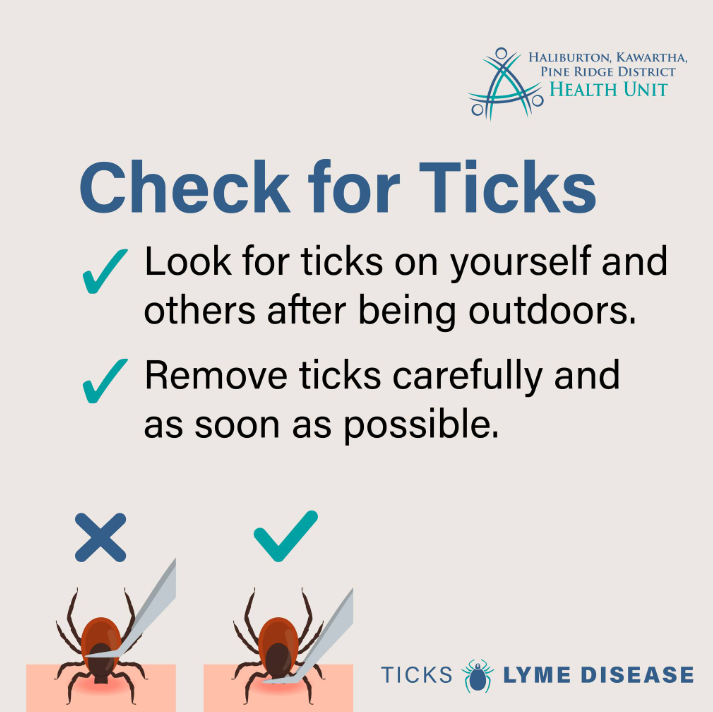
FOCA reminds everyone enjoying the great outdoors to be vigilant daily about ticks. Learn more about Lyme Disease below.

Lyme disease is an infection caused by the corkscrew shaped bacteria, Borrelia burgdorferi. In Ontario, these bacteria are spread by the bite of blacklegged ticks.

Enjoy walks in the woods safely and be aware of ticks that can carry Lyme Disease. Learn what to do if you find a tick, and how to dress to deter ticks, from this online information posted by the Haliburton, Kawartha, Pine Ridge District Health Unit (source of the image at lower left): https://www.hkpr.on.ca/FightTheBite

Consult the Province’s Lyme Disease Risk Map (download a PDF of the 2024 map; source of the image at the right) to see if ticks have already been reported in your area.
Although there are other types of ticks in Ontario (e.g. dog ticks), only the blacklegged tick can transmit Lyme disease. Dog ticks are larger and common all over Ontario, while black legged ticks are smaller with established populations occurring sporadically throughout Ontario. The adults are fairly easy to see on clothing, but the nymphs are much smaller, harder to see and can transmit Lyme disease too. Ticks cannot fly and usually come in contact with people or animals by positioning themselves on tall grass and bushes and grabbing on when you walk by.
- Download FOCA’s fact sheet about ticks and Lyme disease (PDF, 2 pages – source of the iamges below)


If you find an attached tick, use tweezers to carefully remove it. Learn how to remove ticks safety.
NOTE: Public Health Units in Ontario no longer provide testing results for ticks, although they may still provide identification. Ticks submitted for identification are not tested for the bacteria that causes Lyme disease. Instead, consult e-Tick online for assistance identifying ticks.
Download additional ID resources:
- Ticks & Lyme Disease Pamphlet (pdf; 2 pages; created by the Leeds, Grenville and Lanark District Health Unit)
- watch this short video about ticks and Lyme Disease in cottage country, featuring FOCA’s Terry Rees and Dr. Rosana Salvaterra of Peterborough Public Health (2015)
- Get Tick Smart (pdf; 1 page)
- read about Lyme Disease in FOCA’s 2015 Lake Stewards Newsletter – see pages 10-11 for an article written by Dr. R. Pellizzari of the Peterborough City-County Health Unit.


Please note: the following is archival material, and some links to third-party resources may no longer be active.
July 1, 2023 – in response to reports of emerging tick-borne diseases and an increase in blacklegged tick populations across the province, Ontario’s Ministry of Health has made 3 tick-borne diseases – anaplasmosis, babesosis and Powassan virus – reportable as diseases of public health significance. Ontario’s Chief Medical Officer of Health said that anyone who found a tick attached to them should see a doctor if they get a fever within the next month. Read CBC News coverage of this announcement, including an explanation of the signs and symptoms of each disease.
Aug.18, 2022 – Balsam fir needles can kill ticks that cause Lyme disease, Dalhousie researcher finds: New study concludes oil in balsam fir needles is effective in preventing ticks from surviving winter (CBC)
June 1, 2022 – Ticks carrying Lyme disease expand range in Canada (National Observer) – prevalence of ticks that can carry Lyme disease is expected to be higher than ever in much of Canada this year
September 2021 – Peterborough Public Health reports they will no longer accept tick submissions from the public, as the National Microbiology Laboratory is no longer accepting black-legged tick submissions for testing, effective September 20, 2021. As the ticks have been confirmed in many areas within Ontario, the public is being directed to citizen science-based initiatives such as www.etick.ca to submit images for identification instead of specimens. Information is online here.
September 4, 2018 – Creatures vs. climate: The tick –Thanks to warming temperatures, ticks are now establishing populations across Ontario — and they’re bringing Lyme disease with them (TVO)
December 2017 – read this engaging story about climate change impacts on species distribution (including ticks) across Canada: The Great Global Species Shake-Up (Toronto Star)
May 30, 2017 – Federal government announces funding for Lyme disease research ( The Canadian Press)
May 25, 2017 – Time for a Tick Talk… Let’s Fight Lyme Disease! (Haliburton, Kawartha, Pine Ridge District Health Unit)
May 12, 2017 – Get “Tick Smart”! Ticked off: The fight against Ontario’s newest pest (TVO)
Ticks are spreading throughout the province, some bringing Lyme disease with them. The solutions are simple — but educating people about them is not
March 14, 2017 – The Lake of the Woods District Property Owners Association’s newsletter, Area News, includes an update about Lyme disease.
August 2016 – watch this short video interview about ticks and Lyme Disease in cottage country, featuring FOCA’s Terry Rees and Dr. Rosana Salvaterra (formerly Pellizzari) of Peterborough Public Health
July 2016 – Combatting Lyme Disease Through Collaborative Action: Ontario’s 10-Step Education and Awareness Plan
July 29, 2016 – joint news release about Lyme disease by the Minister of Health and Long-Term Care, and Chief Medical Officer of Health: “Keep your summer free of tick bites: Ontarians reminded to lower their risk of Lyme disease.” Read the news release here.
May 17, 2016 – “Lyme Disease Increase” (CBC news item, including video)
Summer 2015 – read about Lyme Disease in FOCA’s Lake Stewards Newsletter – see pages 10-11 for an article written by Dr. R. Pellizzari of the Peterborough City-County Health Unit.

